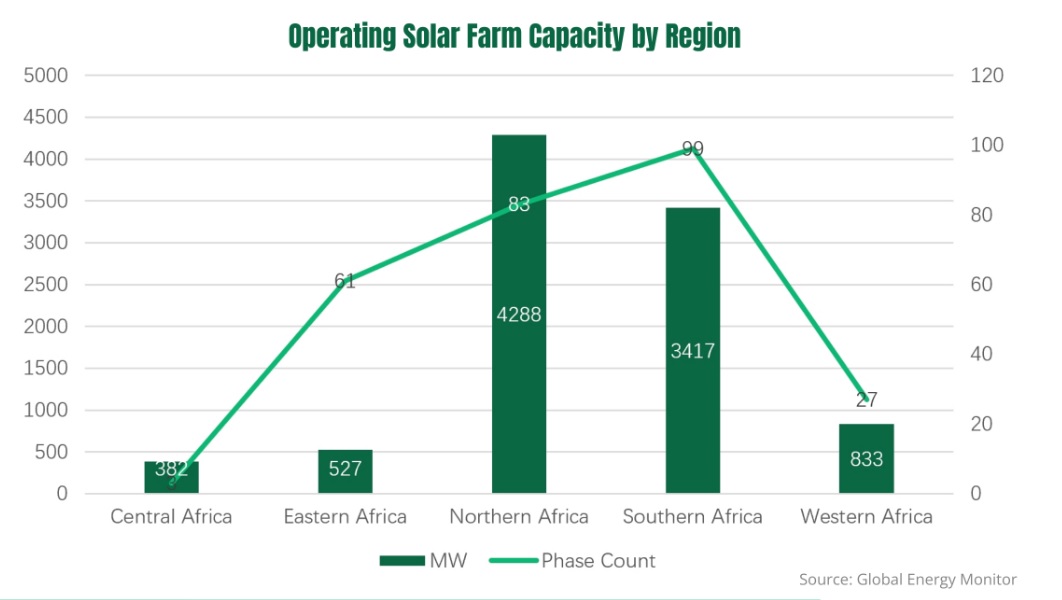Highlights :
Africa has the greatest solar energy potential in the world
Africa’s solar potential of 4.51 kWh/kWp/day outpaces Central and South America’s 4.48, with North America trailing at 4.37
Africa is a gold mine, both literally and figuratively. Providing essential resources for the global transition to clean energy, Africa also holds immense potential for renewable energy development. By 2023, the continent had 62.11 GW of renewable energy capacity installed, a figure that could rise substantially with more funding.
Africa as a continent – and indeed, most African countries – has a greater PV practical potential than China (3.88 kWh/kWp/day), Japan, the UK, and the Global average (4.19 kWh/kWp/day). Therefore, Africa is – in principle – the best frontier to develop more solar power energy. In this blog, we examine Africa’s solar advancements and its prospects as the next solar frontier.

Huge Untapped Solar Potential
The continent of Africa boasts vast resource potential in wind, solar, hydro, and geothermal energy. Central and Southern Africa are rich in minerals essential for producing electric batteries, wind turbines, and other low-carbon technologies. According to a Renewable Energy Market Analysis report by IRENA, Africa has a solar PV technical potential of 7,900 GW. Additionally, the continent has significant potential for hydropower (1,753 GW) and wind energy (461 GW). Certain regions in Africa also possess geothermal and modern bioenergy potential. However, Africa’s solar potential stands out as truly remarkable.
According to World Bank data analyzed by Statista, Africa has the greatest solar energy potential in the world. It is the only region where a measure indicating “excellent conditions for solar power” is exceeded. Africa’s 4.51 kWh/kWp/day outpaces Central and South America’s 4.48, with North America trailing at 4.37. To put this into context, approximately 20 per cent of the world’s population lives in the 70 countries with “excellent conditions” for solar power, exceeding 4.5 kWh/kWp per day. On a continental basis, only Africa’s countries collectively average above this threshold.

While the potential is largely untapped in many less developed countries on the continent, the World Bank’s Global Solar Atlas, whose data Statista analyzed, still describes Africa’s solar potential as a unique opportunity to provide affordable, reliable, and sustainable electricity to those who desperately need improved quality of life and economic opportunities.
What is Stopping the Continent from Realizing its Solar Potential?
Funding remains a significant obstacle on Africa’s path to renewable energy leadership, particularly in solar energy. Over the past two decades, Africa has received just 2 per cent of global investments in renewable energy, highlighting substantial regional disparities. Dependency on grants and aid has further complicated matters, as these sources often do not foster optimal investments in technology or suppliers.
A 2021 report by the IEA, in collaboration with the World Bank and the World Economic Forum, states that annual clean energy investments in emerging markets and developing economies must increase sevenfold by 2030—from less than USD 150 billion in 2021 to over USD 1 trillion—to set the world on track to achieve net-zero emissions by 2050.
Africa holds approximately 60 per cent of the world’s prime solar resources but only accounts for 1 per cent of global solar generation capacity. To meet its current energy and climate goals, the continent needs an annual investment of USD 190 billion between 2026 and 2030, with two-thirds of this funding directed towards clean energy initiatives.
Solar Power in Making
The World Bank, IEA and other partners including the United Nations have recently called for developed economies to provide more support to develop the energy and renewables sectors in developing economies like Africa.

Northern Africa
Northern Africa – comprising Algeria, Egypt, Libya, Morocco, Tunisia, and Sudan – stands as the continent’s largest energy market. The region, apart from Sudan, is characterized by notable socio-economic development, industrialization, and access to modern energy. With one of the highest solar potentials globally, Northern Africa boasts an average annual solar irradiance exceeding 2000 kWh per square meter per year, with standout countries including Egypt and Morocco.
While investments need to be more equitably distributed, most are currently concentrated in Morocco and Egypt. Morocco’s Noor solar project and Egypt’s Benban solar project exemplify the region’s active push for solar growth. Morocco is particularly leading the way to becoming the solar powerhouse in the region. Last year, Morocco launched a renewable energy development project in the Western Sahara region with a massive investment of 20 billion dirhams (USD 1.95 billion). The nation also announced plans to increase investment to USD 1.4 billion annually from 2023 to 2027, aiming to complete approximately 1.3 GW of renewable energy capacity each year within this period.
Together, Morocco and Egypt are expected to add nearly 35 GW of solar by 2030. Several companies, such as AMEA Power, ACWA Power, Scatec Egypt’s New and Renewable Energy Authority (NREA), and the Moroccan Agency for Sustainable Energy (MASEN), are driving these developments.
Southern Africa
Similarly, the lower half of the continent is also looking to exploit its immense solar energy potential, with South Africa being particularly remarkable. Leading not just the southern part of the continent but all of Africa, South Africa had a solar energy capacity of about 7.8 GW, excluding residential solar, in 2023—roughly equal to the combined capacity of other African countries.
In 2023, South Africa installed 79 percent of all new solar capacity on the continent, adding almost 3 GWp out of a total of 3.75 GWp. For two consecutive years, 2022 and 2023, South Africa saw the largest increase in solar installations in African history. Looking forward, the country’s solar energy sector is poised for significant growth, with a projected market expansion of USD 3.74 billion between 2023 and 2028.
Continent at Risk: Need to Fastrack the Investments
Despite contributing only 4 per cent of global greenhouse gas emissions, Africa is one of the most vulnerable regions to climate change. The continent faces challenges such as water scarcity, declining food production, more extreme weather events, and lower economic growth, leading to mass migration and regional instability.
A global ‘climate resilience’ ranking of 136 countries by consultancy Henley and Partners placed eight African countries at the bottom. Africa suffers from the effects of climate change primarily due to emissions from wealthier countries, which score higher on the climate resilience list. The United States, Germany, and the United Kingdom are ranked as the most resilient to climate change.
With nearly 675 million people in Africa—80 per cent of whom live in sub-Saharan Africa—lacking access to electricity, harnessing the continent’s potential is crucial. Solar panel technology, at USD 995/kW, is the cheapest of all renewable technologies. South Africa and Egypt have the largest solar capacities, followed by Algeria. According to the World Bank, by 2030, solar mini-grids could provide high-quality, uninterrupted power to 380 million people.
While solar power can help Africa reduce emissions and expand electricity access, the continent is still in the early stages of building its solar infrastructure. Africa’s solar resources grew by 13 per cent from 2019 to 2020, with 9 per cent of its total electricity now coming from renewable resources, largely from hydropower. Solar’s journey into the mainstream has been slow, hindered by decades of hesitation in adopting new technology.
This hesitation has locked many African countries into high-carbon energy, spending up to six times more on subsidizing fossil fuel consumption than committed under the Paris Agreement.
However, the right policies and regulations can help lower solar development costs, attract cheaper financing, and encourage private investment. According to the World Bank, official development assistance will help drive solar to become the world’s most available energy source in the next three years. Indeed, Africa’s solar progress has the potential to become the next solar frontier.
By Yash Singh
Source link : https://www.saurenergy.com/solar-energy-blog/africa-solar-progress-the-next-solar-frontier
Author :
Publish date : 2024-07-08 04:01:46
Copyright for syndicated content belongs to the linked Source.





